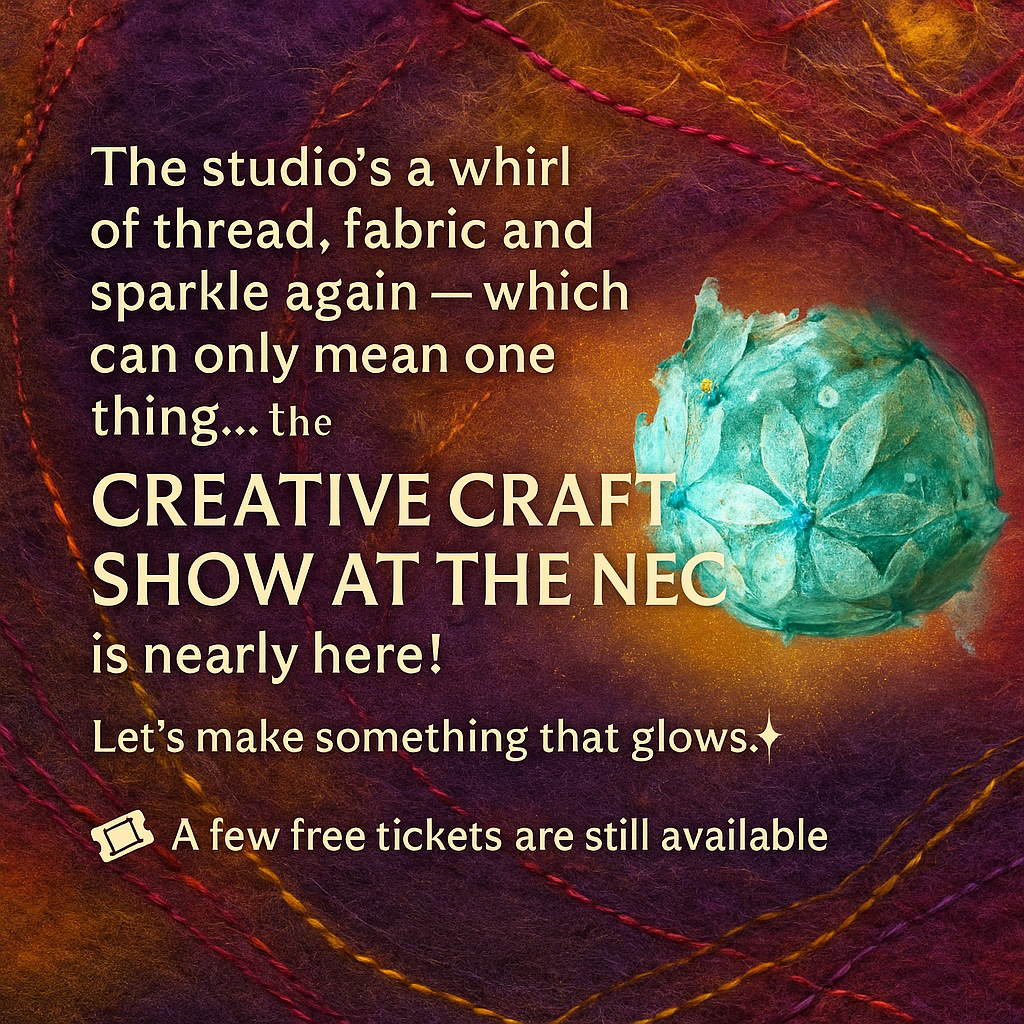6 Benefits of Textile Art
Textile art, also known as fibre art, is a form of art that uses textiles and fibres to create unique, visually stunning pieces. From tapestries to quilts to embroidery, textile art has a rich history and offers a range of benefits for both the artist and the viewer. In this blog post, we'll explore some of the key benefits of textile art.
- Creativity and self-expression are at the heart of textile art workshops. These workshops provide a supportive and nurturing environment for artists to explore their creative instincts and express themselves through various textile techniques.
One of the fascinating aspects of textile art is the sheer range of materials and techniques available. In a workshop setting, you'll have the opportunity to experiment with different types of fibres, fabrics, threads, and embellishments. From natural fibres like cotton and silk to synthetic materials like polyester and nylon, each textile material offers unique properties and possibilities. You can play with textures, densities, and colours to bring your artistic vision to life.
Moreover, textile art workshops often introduce participants to an array of techniques such as embroidery, quilting, weaving, felting, and surface design. These techniques provide a framework for artists to explore and experiment with different artistic approaches. Whether you're drawn to intricate hand embroidery, the rhythmic process of hand quilting, or the innovative techniques of textile surface design, textile art workshops offer a space for you to hone your skills and discover new techniques that resonate with your creative spirit.
The beauty of textile art is that it allows for both planned and spontaneous creativity. Some artists meticulously plan and sketch their designs before diving into the creative process, while others prefer a more intuitive approach, letting the materials guide their artistic choices. Whichever approach you prefer, textile art workshops encourage you to trust your instincts and embrace your unique style.
Additionally, textile art provides a means of storytelling and personal expression. Through your choice of materials, colours, and designs, you can communicate emotions, memories, and narratives in a tactile and visual manner. Textile art often carries a sense of intimacy and personal connection, allowing artists to explore themes that are meaningful to them, whether it's their cultural heritage, environmental concerns, or personal experiences.
In summary, textile art workshops are a haven for creativity and self-expression. They offer a platform to experiment with various materials, techniques, and styles, enabling artists to discover their unique voice and bring their artistic visions to life. Whether you're a seasoned artist or just starting your creative journey, these workshops provide an opportunity to dive into the vibrant world of textile art and express yourself in a truly personal and captivating way.
- Textile art holds a rich cultural and historical significance that spans across centuries and civilisations. It has played a pivotal role in preserving cultural heritage, telling stories, recording history, and expressing identity.
 Throughout history, different cultures have developed unique textile techniques, patterns, and motifs that are deeply intertwined with their traditions, beliefs, and social structures. Textile art workshops provide a gateway to explore these diverse cultural practices, allowing participants to delve into the rich tapestry of human creativity.
Throughout history, different cultures have developed unique textile techniques, patterns, and motifs that are deeply intertwined with their traditions, beliefs, and social structures. Textile art workshops provide a gateway to explore these diverse cultural practices, allowing participants to delve into the rich tapestry of human creativity.By participating in textile art workshops, you gain insights into the techniques and designs that have been passed down through generations. You have the opportunity to learn traditional embroidery stitches, weave on traditional looms, or experiment with patterns inspired by ancient motifs. Engaging with these techniques not only connects you to the cultural heritage of the craft but also provides a deep appreciation for the skill and artistry of the artisans who came before.
Textile art also offers a unique lens into history. Textiles have been used to document historical events, showcase societal structures, and convey narratives of personal and collective experiences. In some cultures, textile art has been employed as a means of communication and storytelling. For example, the intricate tapestries of the Bayeux Tapestry depict the events leading up to the Norman Conquest of England, providing a visual narrative of that significant historical period.
In addition, textiles often serve as powerful symbols of cultural identity. They reflect the traditions, customs, and values of a community or a particular region. Textile art workshops provide an opportunity to explore these identity-rich textiles, from the vibrant Kente cloth of West Africa to the intricate embroidery of Eastern Europe. By engaging with these cultural textiles, you not only learn about the history and symbolism behind them but also contribute to the preservation and appreciation of these artistic traditions.
Textile art workshops also foster cultural exchange and dialogue. Participants from diverse backgrounds can share their own cultural textile practices, techniques, and stories, leading to a deeper understanding and appreciation of each other's heritage. This exchange of knowledge and experiences helps to create a sense of unity and promotes cultural diversity and exclusivity within the textile art community.
In summary, textile art workshops offer an opportunity to explore the cultural and historical significance of textiles. Through engaging with traditional techniques, motifs, and designs, participants gain a deeper understanding of the cultural heritage behind the craft. Textile art serves as a valuable cultural artefact, offering insights into the history, traditions, and identities of communities around the world. By participating in these workshops, you become part of a legacy of artistic expression and contribute to the preservation and celebration of cultural diversity.
- In today's world, where environmental concerns are at the forefront, textile art workshops offer a sustainable and Eco-friendly approach to artistic expression. Many textile artists and workshop facilitators prioritise the use of sustainable materials and techniques, making conscious choices that minimise the environmental impact of their work.
 One of the key ways textile art workshops promote sustainability is through the use of natural fibres. Natural fibres, such as organic cotton, linen, hemp, and silk, are derived from renewable resources and have a lower carbon footprint compared to synthetic fibres. These fibres are often biodegradable, meaning they can break down naturally over time without contributing to pollution or waste.
One of the key ways textile art workshops promote sustainability is through the use of natural fibres. Natural fibres, such as organic cotton, linen, hemp, and silk, are derived from renewable resources and have a lower carbon footprint compared to synthetic fibres. These fibres are often biodegradable, meaning they can break down naturally over time without contributing to pollution or waste.In addition to using natural fibres, textile artists and workshops may also prioritise Eco-friendly dyeing techniques. Natural dyes, derived from plant sources such as roots, leaves, flowers, and bark, offer an environmentally friendly alternative to synthetic dyes. Natural dyes are often non-toxic, biodegradable, and do not release harmful chemicals into the environment during the dyeing process. By using natural dyes, textile artists contribute to the preservation of traditional dyeing practices and reduce the ecological impact of their work.
Furthermore, textile art workshops may encourage participants to re-purpose and up-cycle materials. By reusing existing textiles or re-purposing old garments and fabrics, participants can give new life to discarded materials that would otherwise end up in landfills. This approach reduces the demand for new materials and promotes the concept of sustainable consumption.
Textile art workshops also provide a platform for discussions and education around sustainable practices in the textile industry. Participants can learn about ethical sourcing, fair trade principles, and the importance of supporting local artisans and sustainable supply chains. These discussions foster awareness and inspire individuals to make conscious choices not only in their art practice but also in their everyday lives as consumers.
By incorporating sustainability into textile art workshops, artists and participants play an active role in promoting environmentally responsible practices. They contribute to reducing the carbon footprint, minimising waste, and supporting ethical and sustainable approaches within the textile industry.
In summary, textile art workshops that prioritise sustainability and Eco-friendliness embrace the use of natural fibres, promote the use of natural dyes, encourage re-purposing and up-cycling, and foster discussions around sustainable practices. By adopting these approaches, textile art workshops contribute to a more sustainable future, where artistic expression and environmental consciousness go hand in hand. Participating in such workshops not only allows individuals to create beautiful art but also empowers them to make a positive impact on the planet through their artistic choices.
- Texture and dimension are integral to the beauty and allure of textile art. Unlike two-dimensional art forms, textile art offers a tactile experience that engages multiple senses. The combination of different fibres, fabrics, and techniques creates a rich and varied texture that can add depth, visual interest, and a sense of touch to a space.
 Textile art often incorporates a variety of surface treatments such as embroidery, quilting, weaving, appliqué, and felting. These techniques add layers, patterns, and relief to the artwork, resulting in a three-dimensional quality that can captivate the viewer. Whether it's the raised stitches of embroidery, the intricate patterns of quilting, or the woven textures of a tapestry, textile art engages the eye and invites the viewer to explore its tactile nature.
Textile art often incorporates a variety of surface treatments such as embroidery, quilting, weaving, appliqué, and felting. These techniques add layers, patterns, and relief to the artwork, resulting in a three-dimensional quality that can captivate the viewer. Whether it's the raised stitches of embroidery, the intricate patterns of quilting, or the woven textures of a tapestry, textile art engages the eye and invites the viewer to explore its tactile nature.Furthermore, the unique texture and dimension of textile art make it versatile in its applications. Textile art can be used in various settings, including home décor, fashion, and public art installations.
In home décor, textile art can serve as a statement piece, adding character and warmth to a space. A woven wall hanging, a textile sculpture, or a carefully crafted textile installation can transform a room, creating a focal point and a conversation starter. The tactile nature of textile art in home settings invites touch and interaction, creating a dynamic and engaging atmosphere.
In the realm of fashion, textile art offers endless opportunities for creative expression. Textile artists and designers often collaborate to create unique garments, accessories, and wearable art pieces. From intricately embroidered garments to handwoven accessories, textile art adds an element of individuality and craftsmanship to the world of fashion.
Moreover, textile art has the ability to transcend traditional boundaries and find its place in public art installations. Large-scale textile installations can transform public spaces, adding colour, texture, and a sense of community. Textile art in public spaces creates a sensory experience for viewers, enticing them to interact, touch, and engage with the artwork in a way that is not often possible with other art forms.
The versatility of textile art also extends to its ability to be functional. Quilts, tapestries, and rugs not only add visual interest to a space but also serve a practical purpose by providing warmth, insulation, or a soft surface. Functional textile art pieces blur the lines between art and everyday utility, showcasing the beauty and practicality of textile craftsmanship.
In summary, the texture, dimension, and versatility of textile art make it a captivating and engaging art form. Its tactile nature adds depth and visual interest, while its ability to be incorporated into various settings—from home décor to fashion to public installations—makes it a versatile and dynamic medium. Textile art invites touch, exploration, and interaction, providing a multi-sensory experience that can truly transform spaces and captivate viewers.
- Versatility is a key attribute of textile art, as it can be seamlessly integrated into a wide range of settings and applications. From home décor to fashion to public art installations, textile art offers endless possibilities for creative expression.
 In home décor, textile art adds a unique touch that can elevate the aesthetic appeal of any space. Whether it's a handwoven wall hanging, an intricately embroidered cushion, or a beautifully crafted textile sculpture, textile art brings warmth, texture, and visual interest to a room. The use of different textile techniques, colours, and patterns allows for customisation to match various interior design styles, creating a personalised and inviting atmosphere. Textile art can be used as a focal point or as accent pieces, providing a sense of artistic sophistication and enhancing the overall ambience of a living space.
In home décor, textile art adds a unique touch that can elevate the aesthetic appeal of any space. Whether it's a handwoven wall hanging, an intricately embroidered cushion, or a beautifully crafted textile sculpture, textile art brings warmth, texture, and visual interest to a room. The use of different textile techniques, colours, and patterns allows for customisation to match various interior design styles, creating a personalised and inviting atmosphere. Textile art can be used as a focal point or as accent pieces, providing a sense of artistic sophistication and enhancing the overall ambience of a living space.In the world of fashion, textile art offers endless opportunities for creative exploration. Designers and textile artists often collaborate to create unique garments, accessories, and wearable art. From hand-dyed fabrics to handwoven textiles, textile art adds an element of individuality, craftsmanship, and visual impact to fashion. It allows designers to experiment with different textures, patterns, and embellishments, resulting in one-of-a-kind pieces that reflect artistic vision and personal style. Textile art in fashion blurs the boundaries between art and clothing, transforming garments into wearable expressions of creativity.
Beyond personal adornment and home décor, textile art finds its place in public art installations, enriching urban spaces and engaging communities. Large-scale textile installations can bring vibrancy, colour, and texture to public settings, creating visually striking and interactive experiences. Textile sculptures, tapestries, or suspended fabric artworks can transform public spaces, infusing them with a sense of creativity and inviting viewers to engage with the art on a larger scale. Public art installations using textile art often encourage community involvement, bringing people together and fostering a sense of pride and identity within the shared environment.
One of the remarkable aspects of textile art is its functionality. Textile art pieces, such as quilts, tapestries, and rugs, not only serve as artistic statements but also fulfil practical purposes. Quilts offer warmth and comfort while showcasing intricate patterns and skilled stitching. Tapestries can serve as decorative wall hangings, adding texture and visual interest while providing acoustic benefits by absorbing sound. Rugs, whether handwoven or crafted with innovative techniques, can transform a space by adding warmth, texture, and a sense of grounding. The functionality of these textile art pieces not only enhances their versatility but also reinforces their value as practical and meaningful objects in everyday life.
In summary, the versatility of textile art lies in its ability to seamlessly adapt to different settings and applications. Whether used in home décor, fashion, or public art installations, textile art brings unique textures, patterns, and visual interest to the forefront. Furthermore, the functionality of textile art pieces, such as quilts or tapestries, adds a practical dimension that enhances their versatility and makes them not only aesthetically pleasing but also useful in our daily lives. Textile art truly showcases the harmonious fusion of artistry, craftsmanship, and practicality.
- Textile art extends beyond its visual appeal and practical applications; it also offers a range of therapeutic benefits for both the artist and the viewer. Engaging in textile art can promote relaxation, mindfulness, and a sense of accomplishment, while the viewer can find comfort, inspiration, and a sense of connection through the beauty and craftsmanship of the piece.
 For the artist, textile art can serve as a therapeutic outlet for self-expression and emotional well-being. The process of working with textiles and fibres can be meditative and calming, allowing the artist to enter a state of flow. The rhythmic and repetitive nature of textile techniques, such as weaving, stitching, or knitting, can induce a sense of relaxation and focus. This meditative quality can help reduce stress, anxiety, and promote mental well-being.
For the artist, textile art can serve as a therapeutic outlet for self-expression and emotional well-being. The process of working with textiles and fibres can be meditative and calming, allowing the artist to enter a state of flow. The rhythmic and repetitive nature of textile techniques, such as weaving, stitching, or knitting, can induce a sense of relaxation and focus. This meditative quality can help reduce stress, anxiety, and promote mental well-being.Textile art also provides a tangible and tactile experience for the artist, fostering a deeper connection with the materials and the creative process. The touch and feel of different fibres, the act of manipulating fabric and thread, and the satisfaction of seeing a piece come together can bring a sense of joy, accomplishment, and fulfilment. Creating textile art allows the artist to channel their emotions, thoughts, and experiences into a tangible form, offering a form of self-expression and a means to process and communicate their inner world.
Moreover, textile art can be a form of mindfulness practice. By engaging with the materials, focusing on the present moment, and paying attention to the tactile sensations and rhythmic movements, the artist can cultivate a sense of mindfulness. This mindful engagement with textile art allows for a break from everyday stresses and distractions, fostering a sense of calm and presence.
For the viewer, textile art can be a source of comfort, inspiration, and a connection to something greater. The textures, colours, and craftsmanship of textile pieces can evoke a sense of beauty, serenity, and wonder. Textile art can create a soothing and nurturing environment, providing a sense of sanctuary and respite from the outside world. Whether it's the softness of a quilt, the intricate embroidery of a tapestry, or the patterns and colours of a textile sculpture, textile art invites the viewer to engage with their senses and experience a moment of tranquillity and contemplation.
Textile art can also be a source of inspiration and a catalyst for creativity in the viewer. The intricate techniques, unique designs, and innovative use of materials in textile art can ignite the imagination and spark ideas. Observing the mastery of skilled textile artists can motivate individuals to explore their own creative endeavours and embrace their artistic potential.
In summary, textile art offers therapeutic benefits that extend beyond the artistic realm. For the artist, textile art can promote relaxation, mindfulness, and a sense of accomplishment, providing an outlet for self-expression and emotional well-being. For the viewer, textile art can offer comfort, inspiration, and a connection to beauty and craftsmanship. Engaging with textile art can be a transformative experience, fostering personal growth, and enhancing overall well-being. Whether creating or admiring textile art, its therapeutic qualities can bring a sense of joy, serenity, and meaning to individuals' lives.
In conclusion, textile art offers a range of benefits that make it a unique and valuable form of art. From promoting creativity and self-expression to offering cultural and historical significance, textile art can enrich our lives and enhance our environments. Whether you're a seasoned textile artist or simply appreciate the beauty of fibre art, there's no denying the many benefits of this captivating art form.





Leave a comment